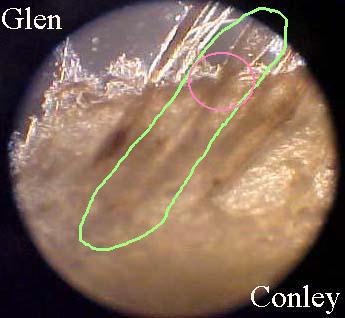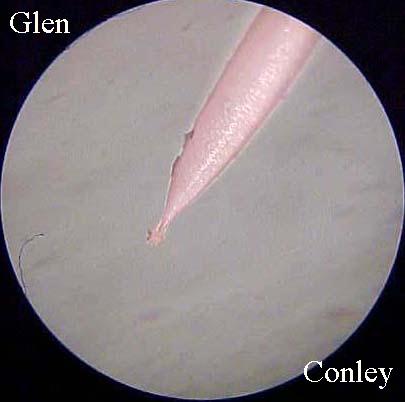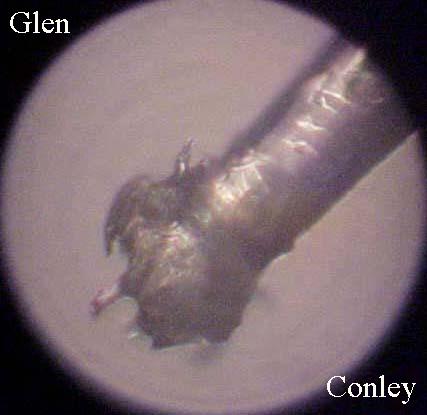Hair slipping, hair slip, slippage, hair shedding are all descriptive terms to describe hair loss on capes, hides, and skins that will be heard with some degree of frequency in the taxidermy, and tanning trades. Slippage, or shedding, of hair can occur before, or after, tanning. Epidermal slippage, or sloughing, can occur before, or after tanning.
The common answer to the question as to what causes these conditions is BACTERIA! Now look at that, a simple one word answer that can explain away just all kinds of problems. The convenience of one word. The average person has heard of bacteria, and spent a bundle on products to kill them off around the home and workplace. They can't be seen with the naked eye, but it is known that they exist, and "something" has happened to produce obvious end results. Very few people have any real idea as to the function, and place in the world, of bacteria, even though their own intestines contain bacteria in astronomical numbers. So, is that why men go bald? Following the same kind of logic, that would have to be the answer now wouldn't it? Sound stupid? Good, then I'm on the right track in communications.
This article, and the photos contained within, should be required reading, and viewing, for every tanner and taxidermist out there. Stick with me, and I'll take your mind and eyeballs places you've never been before. I'll do my best to present things in such a manner that you, yourself, can separate out facts from BULL S(fill in the blank).
When you take a real, honest to goodness, actual LOOK anytime, the guess work is eliminated, and guess work has known to be wrong, especially when a person doesn't know many facts to begin with. By seeing what has actually taken place, factual information is there in front of your very own eyes. Once factual data is gathered, you are ready to start dealing with a problem.
I'm going to call it like it is in this article. If I step on any toes by doing so, accept my apologies now, and get over it. In the past, I have done a few analysis of this nature, and results returned have been done in confidence. Information is something of value, and we all need it, with the keywords here being WE and ALL. By sharing this information here, I know darn good and well the number of people this will wind up reaching world wide over the course of time will be large. And by sharing this information, I might well prevent someone from ruining a client's, or a number of clients, cape or skin, or capes, and skins.
I have pointed out in past articles that there is more than one cause of hair and epidermal slip. And I am going to repeat that here: There is more than one cause of hair and epidermal slip.
What you will be seeing here, in the way of hair slip, has been induced CHEMICALLY, and by the time you get to the last photo, I defy anyone to find ANY bacteria present.
By pointing out hair and epidermal slips can be induced CHEMICALLY that does indeed shift the "Burden of Responsibility", doesn't it? You might want to think twice before you start pulling stuff out from underneath the kitchen sink, and putting it to use. Some people are luckier than others.
Let's do a quick biology refresher course. Carbon based life form, you've heard the term before. Atoms of carbon, hydrogen, and oxygen, and to make proteins, we add nitrogen. These atoms are arranged in different numbers, sequences, and ratios to make molecules that in turn can "make" carbon based life forms. Needless to say, we are going to have to add some more elements to make living forms, but right now, we aren't dealing with living, we're dealing with dead.
If I were to say that there were "objects of the game" in regards to tanning, I would say that it would be to take the proteins down to their most simple, but stable form, but they at that point will be a highly digestible food source for a number of creatures, that could take in creatures from bacteria to man. So, the next object or objects, would be to render these proteins unsuitable as a food source, and also prevent further degradations, or break downs, by atmospheric conditions. There is more than one way to get to that end product.
Carbon based life form........did you ever stop to think about plastic being made up of carbon, hydrogen, and oxygen? Have you ever heated plastic up to the point you could shape it? Have you ever melted it, to have it return to it's original hardness once cooled? Have you ever burned it?
Have you ever heard of some guy getting careless with acid, and getting an ACID FREEZE on his hand? Me neither.
I'm willing to bet that at least ten percent of the general populace is unaware that proteins are crystalline structures, and as crystalline organic compounds, they have a melting point, and if they become hot enough in a fluid solution, they can disassociate (come apart).
Back to that plastic, have you ever burned the trash, and had plastic melt down around broken glass, or nails, and then once that has cooled, the glass and nails are a "permanent" part of this new shape?
Did you ever think about acid as a heat source? You just did, the guy didn't acid freeze his hand. See how easy it is to use your OWN brain?
The photos I'm presenting here, I've had in file for a little over a year prior to this writing (May '04).
There were several tanneries having some degree of problems with shedding of finished goods. The guy that I was working directly with on this is a GOOD, talented tanner. He was also objectively honest, and a good observer. Working with someone like that can help get to the bottom of things real quick.
The shedding was not confined to animals from one geographical location, nor was it confined to one genus, or species. That eliminates a lot of possibilities right there. Once I received samples, so that LOOK could be taken, it didn't take but minutes to see what had happened. The hairs had been burned in two.
With that factual data, a phone call and questions, and questions answered, a source for the problem was identified.
It seems the tanneries that were having the problem were all using the same basic techniques, and materials. The materials were coming from two different commercial tanning chemicals suppliers. In an effort to try to produce the best goods possible for their customers, they had "hybridized" two different systems, and they did indeed produce some nice leather, BUT the heat produced by the chemical reactions as a result of incompatibilities was enough to burn some of the hair in two. The fix was simple enough, use only one supplier's line.
This first photo is of a cross section of skin. It takes in what WAS the epidermis, hair follicles, and what WAS the collagen structures. By WAS, I mean these guys were able to successfully "melt, and dissolve" the protein structures together, and intersperse a tanning agent throughout. Remember the plastic in the burned trash analogy?
They had used a "HOT" acid for their pickle solution. Milder acids will not normally do this much "melting and dissolving", and the epidermal cell membranes will be more defined. The underlying collagen fibres will be more intact, and depending on the acid used, and an individual's skill, will be usually something between the original collagen structure, and what you see here.
The lime green oval identifies a single caribou hair, both in the epidermis and as it comes out of the epidermis, you can see that the oval also takes in the hair follicle.
The pink circle draws attention to the area from which the hair emerges from the epidermis. Notice the bottle necking, or hour glass waist shape, of the hair and the way the epidermis is bunched up around it. You will also see what looks like as if a scorching has taken place. The hair follicle right next to it appears to have suffered a greater degree of scorching.
The bottle necking, or restriction, should not be there. The hair is weakened at that point but definitely still intact. No big deal, but when you see the photo of one of the "shed" hairs, you will be better able to understand that it can be a big deal. It is weak, brittle, and easily broken.
Hair slippage, or shedding of this nature does not especially need a microscope to identify the problem. Good eyes, and a strong magnifying glass can frequently show the presence, or absence of a hair follicle.
Now again, this form was induced by the addition of incompatible chemicals, BUT there is also a similar form to this slip that is induced NATURALLY. The difference will show up under magnification.
With the naturally occuring form (brought on by death of the animal), there will be a stubble, not unlike beard stubble, that will be just a little higher than the epidermis. The hair shaft will be burned in two higher up the shaft than what you just saw here.
This naturally occuring form has been of interest to me. It can work QUICK, quicker than any bacteria could ever start to.
I have been aware of the ammonium chloride reaction since I was in my teens (many winters ago), but in the past four or five years, I have only been able to come up with one other person that had a clue as to what I was talking, or asking about. He thought it was catalyzed by different body acids than what I did, but regardless, STOP-ROT can stop it.
You have probably been exposed to the ammonium chloride reaction before. When you have those raw skins, or hides piled up, and you have touched them and felt heat, that's the result of the reaction.
Of late, I had a few different taxidermist ask me if STOP-ROT would stop slipping on a tanned hide. I said probably not. Each of them took the attitude that they had nothing to lose, and tried it any way. They stopped the slippage. At times, it's not all bad to be proven wrong. Since then, I have had the opportunity to verify their findings.
I already knew that STOP-ROT would bond household ammonia. I have frequently used ammonia as my ammonium ion source for testing. I went further with that to find that STOP-ROT will bond Fantastik cleaner, and dog urine. Dog urine is high in amines. STOP-ROT and dog urine together did not produce the ammonia as did the control samples. There's some food for thought in this last paragraph, if you want to sort it out.
If this wasn't enough to whet your appetite in your quest for knowledge, below are some links to more microphotography and data of this nature.
Understanding the Lack of Stretch of a Tanned Cape
If you have not yet bought yourself a birthday present, and a microscope would be the thing to have to see what all you have been missing, this link can save you some searching:



